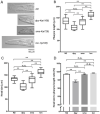Morphological Characterization of small, dumpy, and long Phenotypes in Caenorhabditis elegans
- PMID: 33692220
- PMCID: PMC8019597
- DOI: 10.14348/molcells.2021.2236
Morphological Characterization of small, dumpy, and long Phenotypes in Caenorhabditis elegans
Abstract
The determinant factors of an organism's size during animal development have been explored from various angles but remain partially understood. In Caenorhabditis elegans, many genes affecting cuticle structure, cell growth, and proliferation have been identified to regulate the worm's overall morphology, including body size. While various mutations in those genes directly result in changes in the morphological phenotypes, there is still a need for established, clear, and distinct standards to determine the apparent abnormality in a worm's size and shape. In this study, we measured the body length, body width, terminal bulb length, and head size of mutant worms with reported Dumpy (Dpy), Small (Sma) or Long (Lon) phenotypes by plotting and comparing their respective ratios of various parameters. These results show that the Sma phenotypes are proportionally smaller overall with mild stoutness, and Dpy phenotypes are significantly stouter and have disproportionally small head size. This study provides a standard platform for determining morphological phenotypes designating and annotating mutants that exhibit body shape variations, defining the morphological phenotype of previously unexamined mutants.
Keywords: Caenorhabditis elegans; K-means clustering; dumpy; long; small.
Conflict of interest statement
The authors have no potential conflicts of interest to disclose.
Figures





References
-
- Bar D.Z., Charar C., Dorfman J., Yadid T., Tafforeau L., Lafontaine D.L.J., Gruenbaum Y. Cell size and fat content of dietary-restricted Caenorhabditis elegans are regulated by ATX-2, an mTOR repressor. Proc. Natl. Acad. Sci. U. S. A. 2016;113:E4620–E4629. doi: 10.1073/pnas.1512156113. - DOI - PMC - PubMed
MeSH terms
Substances
Grants and funding
LinkOut - more resources
Full Text Sources
Other Literature Sources
Research Materials

